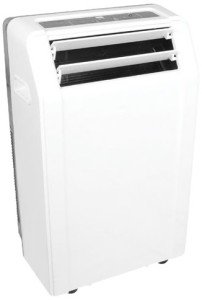A portable room air conditioner is a great option when you want to cool a small area and a window unit doesn’t work. For example, these units would work great in basements or computer server rooms. A benefit of one of these units is that they are much easier to install than a window air conditioner. Also, you may prefer the look and functionality of a portable single room air conditioner. You won’t have a big unit hanging out of a window possibly blocking your view or making it an eye sore for you home.
Other benefits of a portable single room air conditioner is that it can be used in addition to a central heating and cooling system. These units give you the ability to cool just a room instead of having to cool the entire home. You can keep your thermostat on a higher setting and save money on electricity. Some units even have heating options and could be used as humidifiers as well. For a great unit that works well and has high ratings, visit this page.
There are some things to keep in mind when setting up one of these units. First, be sure the unit is able to cool the size of the room you are using it in. There are units that range from 200-600 sq. feet (rooms that are 10’x20′ up to 20’x30′). Once you know the proper dimensions of the room, you can select the best portable air conditioner for your needs
Also, there must be a way for the unit to vent out hot air to the outside. Many units include these venting kits, but if not, you can purchase one like this one. Just open a window and install the kit. Because of the ability of kits to be adjusted, the unit it can be installed using a variety of window types, instead of just traditional windows as in the case of a window unit. For an example of a window kit, click here.
How to Install a Portable Room Air Conditioner
Now that we’ve covered the basics, let’s go over how to install a portable air conditioner:
-
Because of the weight of the unit, you may need some to help you get it out of the box. Once the unit is out, remove all packaging and read the instructions carefully.
-
Check to see that the ventilation kit will fit your size of window. The kit should be flexible enough to fit both vertical and casement (horizontal) opening windows. Check the manual to verify minimum and maximum window sizes.
-
Your unit should have a foam seal with adhesive backing. Cut it to fit all four sides of the opening. The opening of the window needs to be the height of the vent pannel assembly. (For more details, please refer to your owner’s manual).
-
Insert the vent panel assembly into the window opening and extend any extension panels that you may be using to close the opening.
-
Carefully lower the window. To secure the panel assembly, please use the enclosed screws. If you do not want to damage the window with screws, you can use artist’s tape or a similar adhesive tape to secure the panel assembly. If your unit comes with non-adhesive foam, use it to close any gaps between the glass and the window to prevent air flow and insects from coming in.
-
For security reasons, most kits come with security brackets that can be screwed into the window frame. If you are concerned about damaging the window, you could use an adapter like this one as well.
-
Now, install the plastic end of the diffuser into the opening in the panel assembly and the other end to the air conditioner. The unit is ready to be plugged in and turned on.
-
Be sure to insert the batteries into the enclosed remote control and power up the unit. If the unit does not power on, check to see if the power chord has a reset button. It may need to be pressed. Please refer to your owner’s manual for more details.
You should now be able to enjoy your new portable air conditioner! If you have any issues, please refer to your owner’s manual and follow it’s recommendations.

Pingback: 5 Reasons to Buy Portable Air Conditioner | The DIY Air Conditioner Blog